1080 Ti Mini Review Tom's Hardware
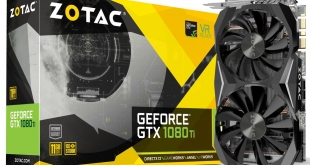
Since the launch of Nvidia'due south GTX 1080 Ti back in February, nosotros have seen enough of aftermarket cards from the likes of ASUS, MSI and Gigabyte to proper noun just three. Today we analyse the Zotac GTX 1080 Ti Mini, most notable for its diminutive size. In fact, the Mini is really the smallest GTX 1080 Ti on the market right now – so how does its size touch on its performance?
If you have been reading our graphics cards reviews for the final few months, you will take noticed a certain tendency among many of the aftermarket GTX 1080 Ti cards – they are alllarge. I don't just hateful large in terms of length – though many are approaching 30cm long – just too in terms ofheight. To demonstrate this, merely look at the ASUS ROG Strix, MSI Lighting and Gigabyte Aorus models – all 3 are two-and-a-half slot cards, something which has definitely become the standard for 3rd party GTX 1080 Ti cooling solutions.
Lookout man via our VIMEO Channel (beneath) or over on YouTube at 2160p HERE.
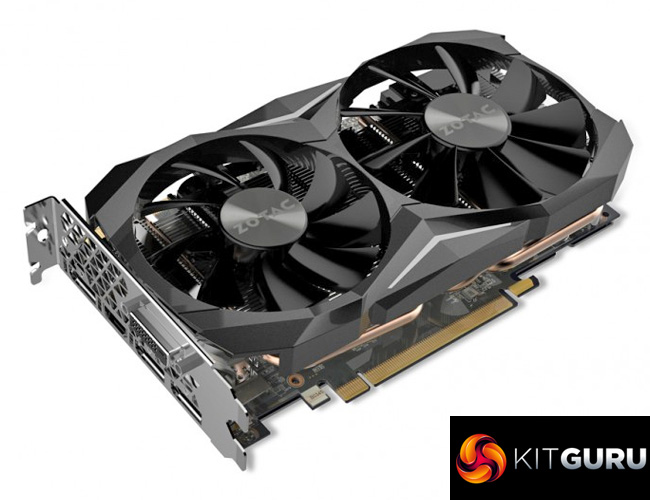
With that in mind, information technology becomes quite apparent what theZotac GTX 1080 Ti Mini is upwards against. Non only is the Mini 'just' a two-slot menu, it is too incredibly brusque at 211mm, and this plainly limits the amount of infinite for its heatsink and fans. Cooling performance will thus exist interesting to assess, peculiarly when compared to Nvidia'due south reference GTX 1080 Ti Founders Edition.
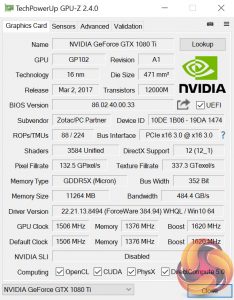
That being said, Zotac has still added +38MHz to the boost clock then, in theory at least, performance should be marginally improve than a standard GTX 1080 Ti FE. For full clock speed comparison, check out this table below:
| GPU | Nvidia GTX 1080 Ti Founders Edition | Zotac GTX 1080 Ti Mini |
| Base Clock | 1480 MHz | 1506 MHz |
| GPU Heave Clock | 1582 MHz | 1620 MHz |
| Memory Clock Effective | 11008MHz | 11010MHz |
| Memory Bandwidth | 484 GB/due south | 484 GB/s |
| Price (£) | £689 | £699 |
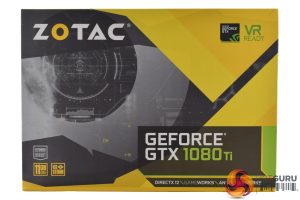
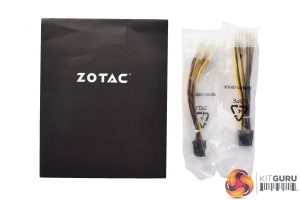
Zotac is well known for its yellow products and boxes, and the GTX 1080 Ti Mini box is no unlike.
Inside, accessories are scarce: there is a black booklet containing warranty and quick-beginning information, as well as two 2x 6-pivot to eight-pin power adapters.
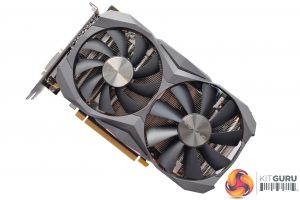
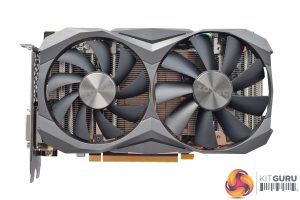
Now, moving onto the card itself, the GTX 1080 Ti Mini (or just the 'Mini' from here on) is an bonny slice of kit, but it is patently very small. The total dimensions are equally follows: 211mm x 125mm ten 41mm. Clearly, this 1080 Ti should fit in just most whatsoever case on the market.
The shroud is made from a gunmetal grayness plastic, and this color is consistent throughout. It is non a black card, but the grey is certainly colour-neutral enough for it not to cause issues with the rest of your system should you have a item colour scheme going on.
Elsewhere, the keen-eyed amidst you lot may well accept noticed that the card'southward two fans are not only different sizes, they also utilize different fan blade designs. The fan on the left (when seen from above) is 90mm and uses swept fan blades, while the fan on the right is 100mm in size and uses much straighter, flatter fan blades.
Zotac has not told mewhy they accept done this, but my guess is that the dissimilar fans are each designed to give slightly different air pressure levels to aid cooling of the GPU cadre, VRMs and memory chips as well every bit potentially reduce air turbulence.
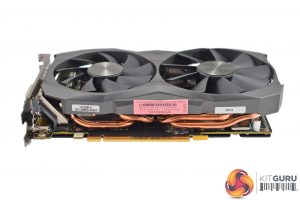
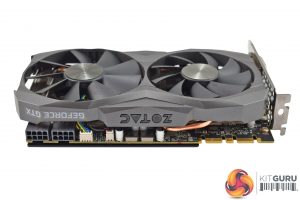
Speaking of cooling, on 1 side of the Mini we get a look at four copper heatpipes, all 6mm thick, while a single heatpipes is visible from the other side. That gives a total of 5x6mm copper heatpipes. The pipes themselves aren't plated either, so the raw copper look may not exist for anybody, but you lot won't see the heatpipes once the card is installed anyway.
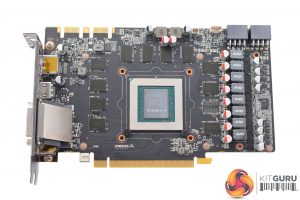
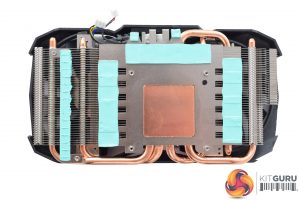
Prising the libation from the PCB (done by only removing 6 screws from the backplate) gives a better look at the heatpipe layout and the copper contact area. Information technology likewise becomes fairly obvious that the heatsink is non large – far from it. The heatsink fins are quite densely stacked, just the card is but too brusque to let for a more than sophisticated cooling solution. Nosotros await at thermals, acoustics and ability consumption later in the review.
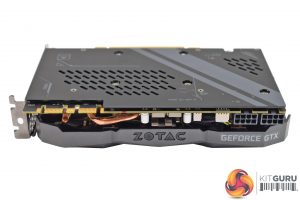
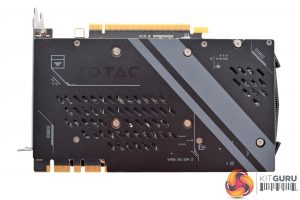
Moving on, the Mini sports a Zotac logo on its outer edge and this logo is illuminated by white-only LEDs. Interestingly enough, Zotac deliberately eschewed RGB lighting to effort and keep the card as small as possible – having a RGB-illuminated logo would require an RGB controller on the bill of fare, something Zotac says would've required a longer PCB.
The bill of fare'south backplate is besides very tasteful, with a two-tone look that retains the card's colour-neutrality without being boring and evidently. This is certainly an improvement over Zotac'south previous backplate designs – like the GTX 1080 Amp Extreme, for instance – which ofttimes featured bright yellow accents. Those designs may expect good on their own, just they suit very few systems. The Mini, however, would not be out of identify in whatever rig.
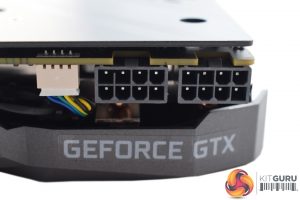
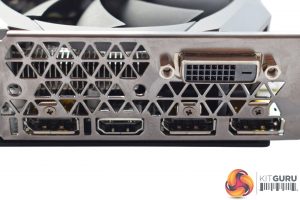
Elsewhere, the Mini sports dual 8-pin PCIe power connectors, and Zotac rates the card's ability consumption at 250W.
Lastly, the display connectors are worth noting: 3 10 DisplayPort 1.4 , HDMI two.0b and DL-DVI-D. The latter is obviously something Zotac decided was worth including as Nvidia ditched the DVI connector on its Founders Edition cards, but it is back here.Our newest GPU test procedure has been built with the intention of benchmarking high-end graphics cards. Nosotros test at 1920×1080 (1080p), 2560×1440 (1440p), and 3840×2160 (4K UHD) resolutions.
We try to test using the DX12 API if titles offer support. This gives us an interpretation into the graphics card performance hierarchy in the nowadays time and the virtually future, when DX12 becomes more prevalent. After all, graphics cards of this expense may stay in a gamer's system for a number of production generations/years before existence upgraded.
Note: Nosotros tested the RX Vega64 and Vega56 using the 'Turbo' ability mode in AMD'southward WattMan software. This prioritises all-out performance over power efficiency, noise output, and lower thermals.
General Test Organization Notes
- AMD Graphics cards were benchmarked with the AMD Crimson ReLive 17.9.1 commuter.
- Nvidia Graphics cards were benchmarked with the Nvidia 384.94 driver.
Test System
| CPU | Intel Core i7-7700K 'Kaby Lake'(Retail) |
| Motherboard | ASUS Z170 Pro Gaming |
| Memory | Geil Evo X |
| Graphics Carte | Varies |
| Organization Drive | Sandisk SSD PLUS 120GB |
| Games Drive | Crucial M4 512GB |
| Chassis | Game Max Moonstone (loftier fan speed) |
| CPU Libation | Fractal Design Celsius S24 |
| Power Supply | Seasonic Prime number 1000W Platinum |
| Operating System | Windows 10 Professional person with Creators' Update (64-bit) |
Our test system consists of an overclocked Core i7-7700K processor and 16GB of 3200MHz Geil DDR4. High-end hardware is used to eliminate CPU and retentiveness from the clogging equation and put the operation onus solely on the GPU being tested.
Comparing Graphics Cards List
AMD Radeon RX Vega64 Air (1247MHz core / 1546MHz Average Heave / 1.89Gbps HBM2 memory)
AMD Radeon RX Vega56 Air (1156MHz cadre / 1471MHz Average Heave / 1.6Gbps HBM2 memory)
Nvidia GTX 1080 Ti Reference (1480MHz core / 1582MHz Heave / 11Gbps GDDR5X memory)
Gigabyte GTX 1080 G1 Gaming (1696MHz cadre/ 1835MHz Heave / 10Gbps GDDR5X memory)
Nvidia GTX 1070 Founders Edition(1506MHz core/ 1683MHz boost / 8Gbps GDDR5 retentiveness)
Software and Games List
- 3DMark Fire Strike & Burn down Strike Ultra (DX11 Synthetic)
- 3DMark Time Spy (DX12 Synthetic)
- Ashes of the Singularity: Escalation (DX12)
- Deus Ex: Mankind Divided (DX12)
- Ghost Recon Wildlands (DX11)
- Yard Theft Auto Five (DX11)
- Ascension of the Tomb Raider (DX12)
3DMark Fire Strike is a showcase DirectX 11 benchmark designed for today'due south loftier-functioning gaming PCs. It is our [FutureMark's] most ambitious and technical criterion ever, featuring real-time graphics rendered with item and complexity far beyond what is found in other benchmarks and games today.
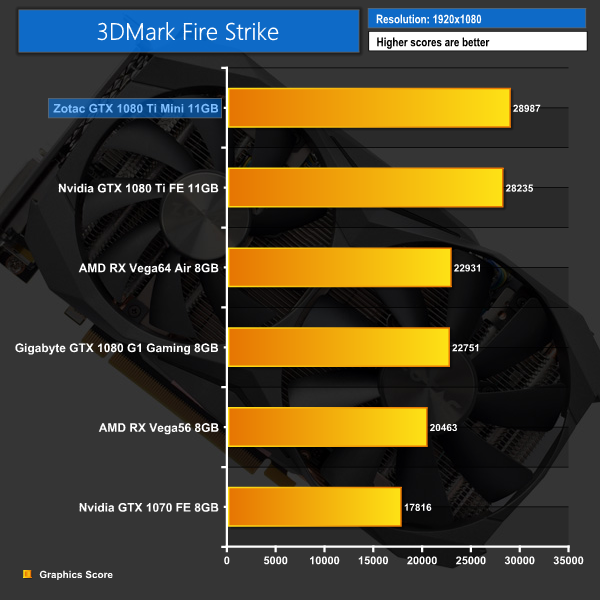
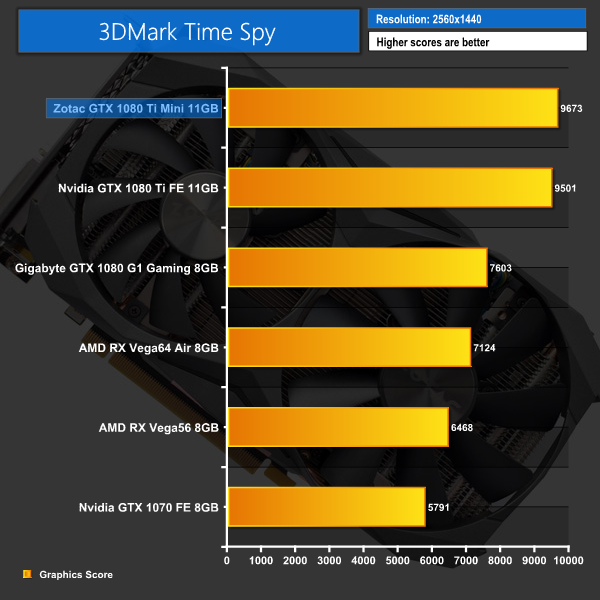
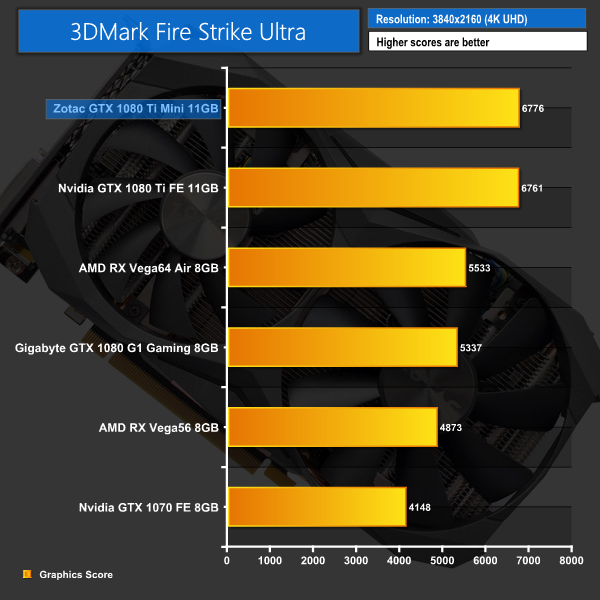
Early on indicators are good for the Zotac Mini every bit information technology pulls ahead in all three 3DMark synthetic tests. This would be due to the minor +38MHz mill overclock which means the Mini edges out Nvidia's reference design. Ashes of the Singularity: Escalation is a real-time strategy game set in the future where descendants of humans (called Post- Humans) and a powerful bogus intelligence (called the Substrate) fight a war for control of a resource known equally Turinium.
Players will engage in massive-scale land/air battles by commanding entire armies of their own design. Each game takes place on one expanse of a planet, with each player starting with a home base (known as a Nexus) and a single construction unit of measurement.
We opt for theExtremequality profile and run the GPU-Focused test using the DX12 game mode.


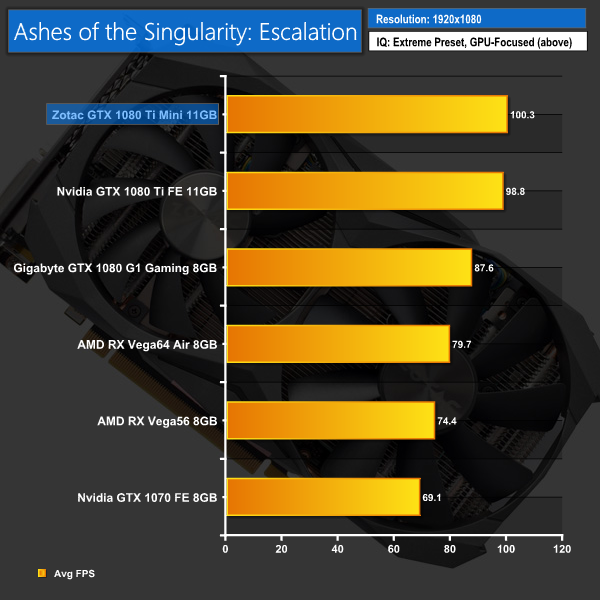
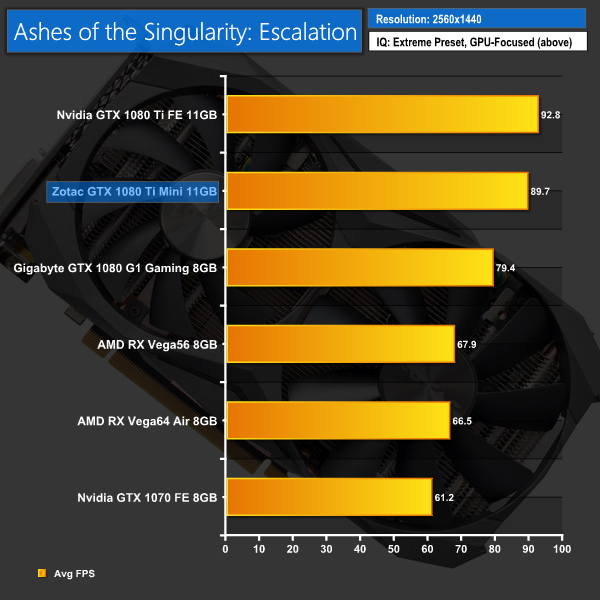
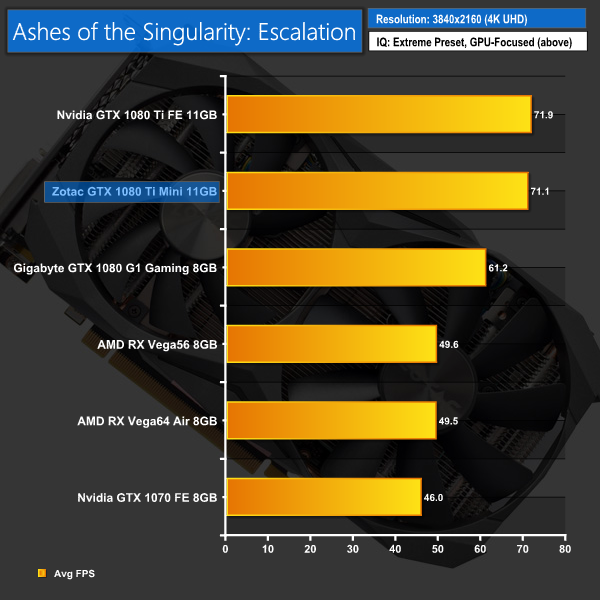
Ashes deviates from the trend nosotros saw across our 3DMark testing – equally at both 1440p and 4K, the Zotac Mini card falls backside Nvidia's Founders Edition (Fe) card. Analysis of the GPU clock speeds show that this was because the Mini card was unable to maintain its frequency reward over the Founders Edition due to thermal limitations. In short, the Zotac Mini got hot, so Nvidia's GPU Boost 3.0 tech reined in its core speed – thus causing the Mini to autumn behind Nvidia's 1080 Ti Atomic number 26. Deus Ex: Mankind Divided is ready in the year 2029, two years after the events ofHuman Revolutionand the "Aug Incident"—an consequence in which mechanically augmented humans became uncontrollable and lethally violent.
Unbeknownst to the public, the affected augmented received implanted technology designed to control them by the shadowy Illuminati, which is abused past a rogue member of the group to ignominy augmentations completely. (Wikipedia).
TheVery High preset was used for 1080P, 1440P, and 4K. We used the DirectX 12 API.
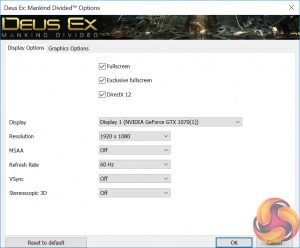
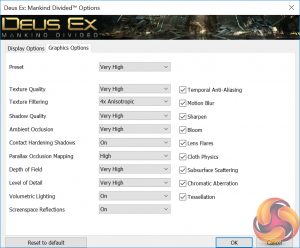
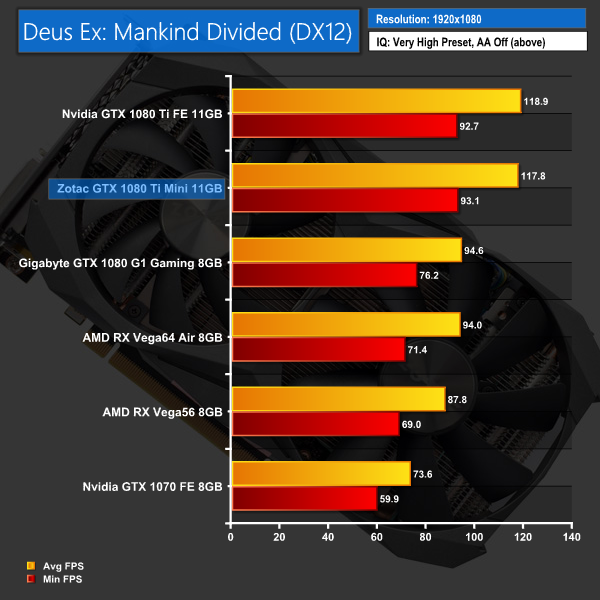
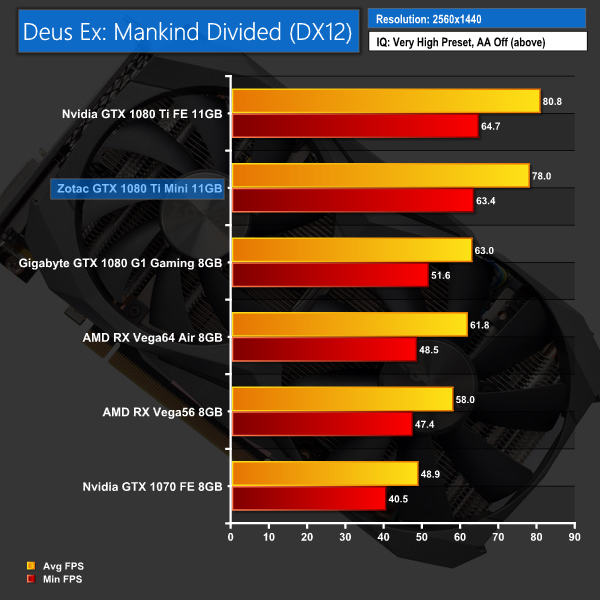
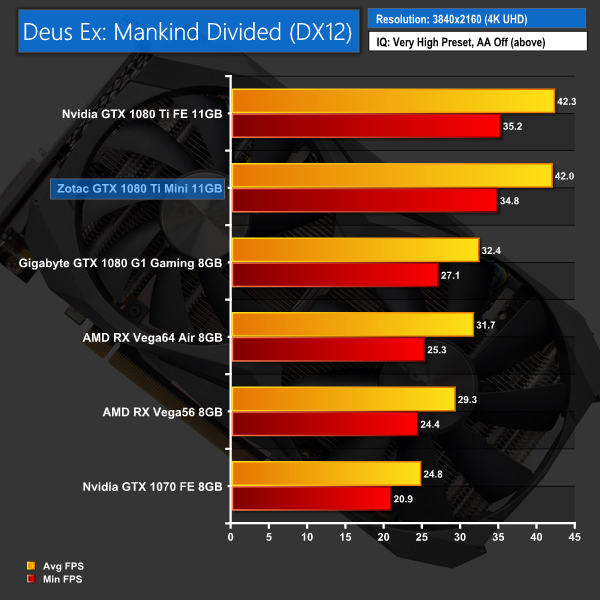
Equally with Ashes, the Zotac Mini falls behind Nvidia's 1080 Ti FE – this time at every resolution tested. The margins are by no means big, with the widest gap being just just under 3 frames per second, but it is interesting all the same given i would think Zotac's card, with its factory overclock, would be the faster 1080 Ti.
Obviously, in that location is more to the story than only factory clock speeds. Tom Clancy's Ghost Recon: Wildlands is an open world tactical shooter video game developed by Ubisoft Paris. Information technology is the 10th instalment in the Tom Clancy's Ghost Recon franchise and is the first Ghost Recon game to feature an open world environs.
We run the built-in benchmark using theVery High quality preset at 1080P, 1440P, and 4K.
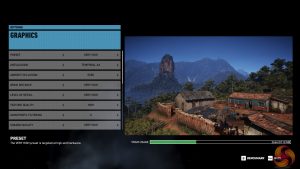


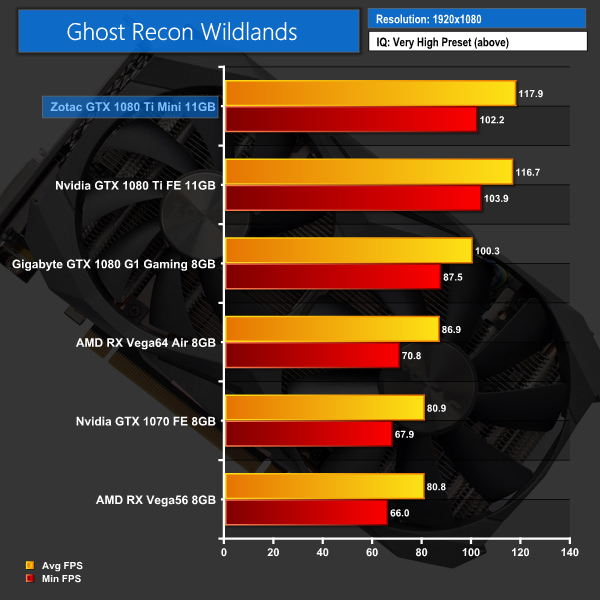
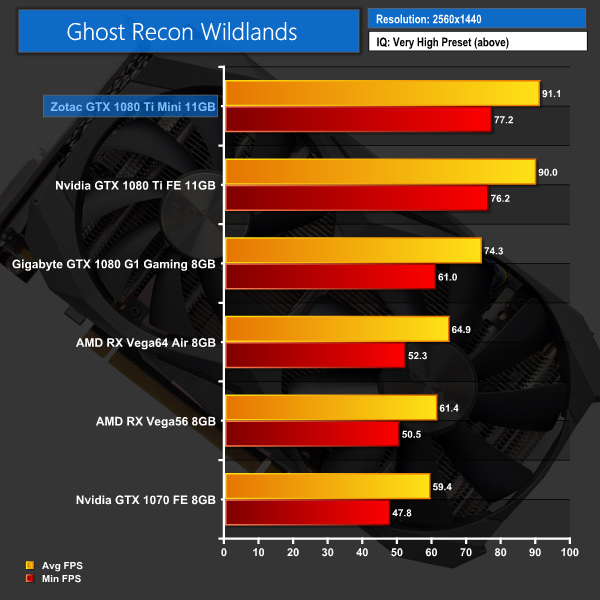
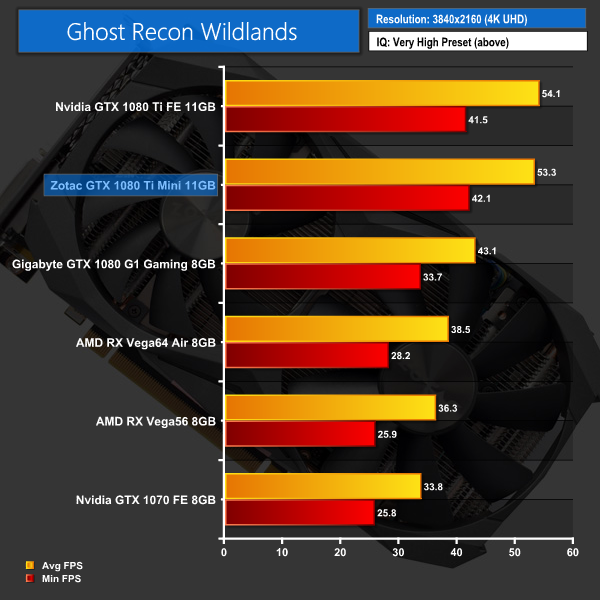
Zotac's GTX 1080 Ti Mini only about edges the Nvidia FE card at 1080p and 1440p resolutions, though it falls behind by less than ane FPS once the resolution is bumped upward to 4K. Incidentally, the gap betwixt both 1080 Tis is non much more a single frame per second across all iii resolutions, so there really is non much between the two cards. Grand Theft Motorcar V is an activity-adventure game played from either a first-person or third-person view. Players complete missions—linear scenarios with ready objectives—to progress through the story. Outside of missions, players may freely roam the open globe.
Composed of the San Andreas open countryside expanse and the fictional metropolis of Los Santos, the earth is much larger in area than earlier entries in the serial. Information technology may be fully explored afterwards the game's kickoff without restriction, although story progress unlocks more gameplay content.
Nosotros use theUltra quality settings (or the highest alternative – generallyVery Highor High – whenUltra is unavailable).MSAA is prepare to 2x for 1080p and 1440p and is disabled for 4K. TheAvant-garde Graphics options are all set to their maximum levels.
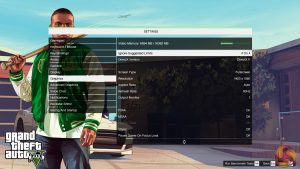
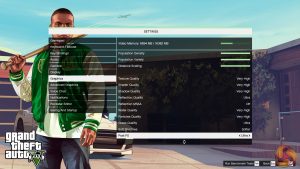
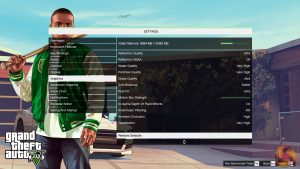

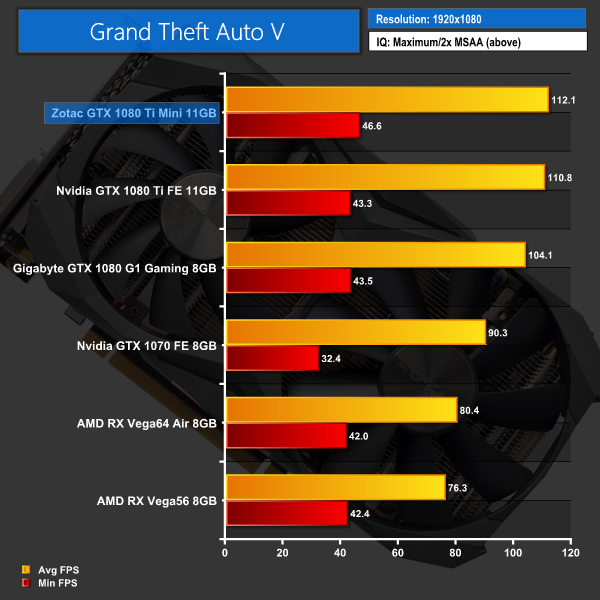
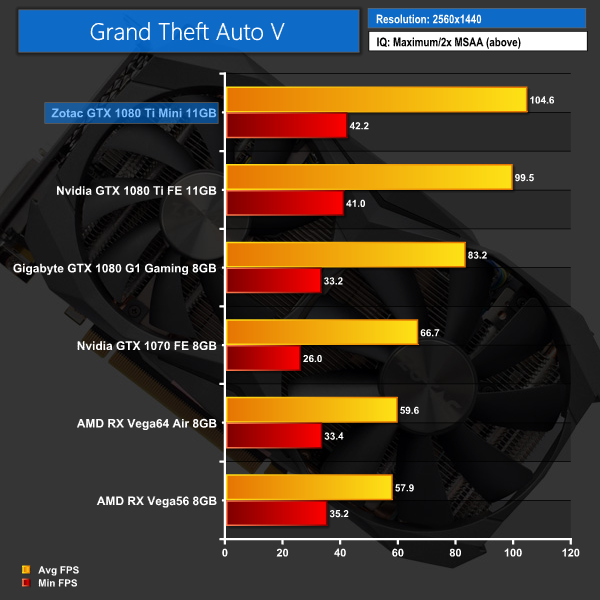
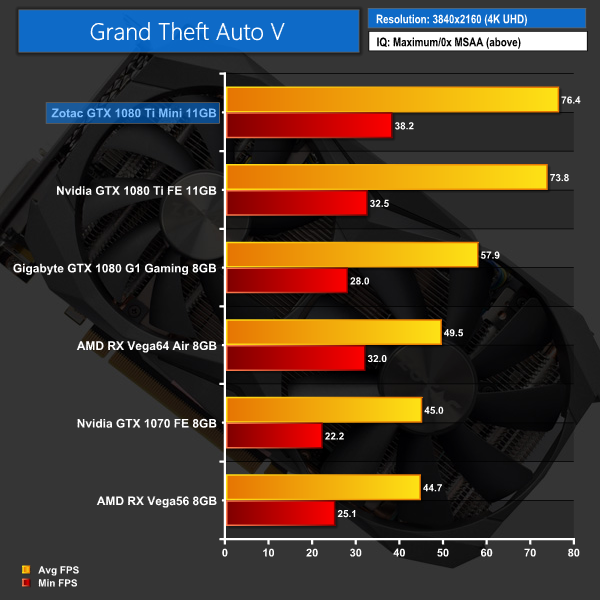
Coming to the ever popular GTA V, here the Zotac Mini comes out pinnacle across all 3 resolutions for the unproblematic reason that, during GTA V benchmarking, information technology held its boost clock consistently higher than the Nvidia's Fe card. The frame rates themselves are too very strong, even at 4K. Rise of the Tomb Raider is a third-person activeness-risk game that features like gameplay constitute in 2013'southwardTomb Raider. Players command Lara Croft through various environments, battling enemies, and completing puzzle platforming sections, while using improvised weapons and gadgets in society to progress through the story.
Information technology uses a Direct X 12 capable engine.
At 1080p and 1440p, we employ theVery High quality preset and 2x SSAA. At 4K we utilize SMAA. The DirectX 12 API is used. Numbers are taken from the benchmark'sGeothermal Valley examination.
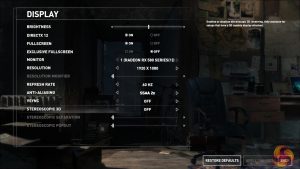
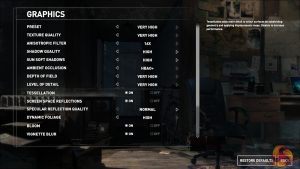
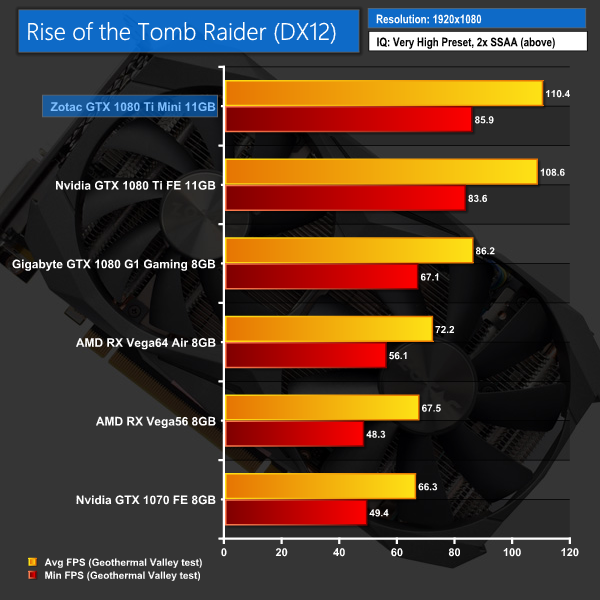
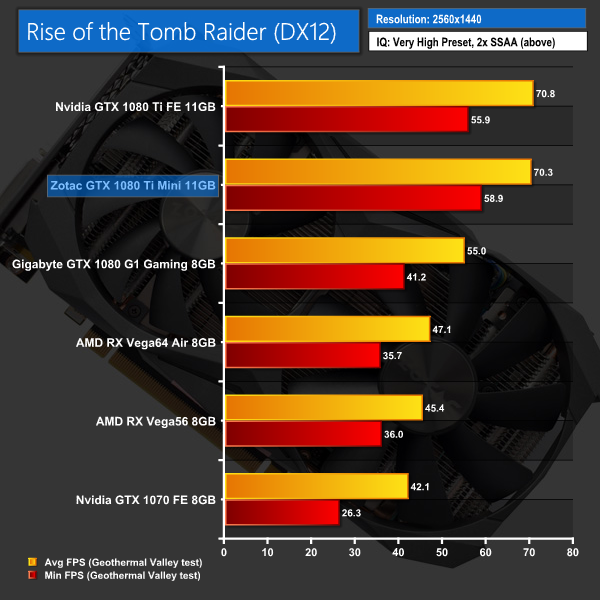
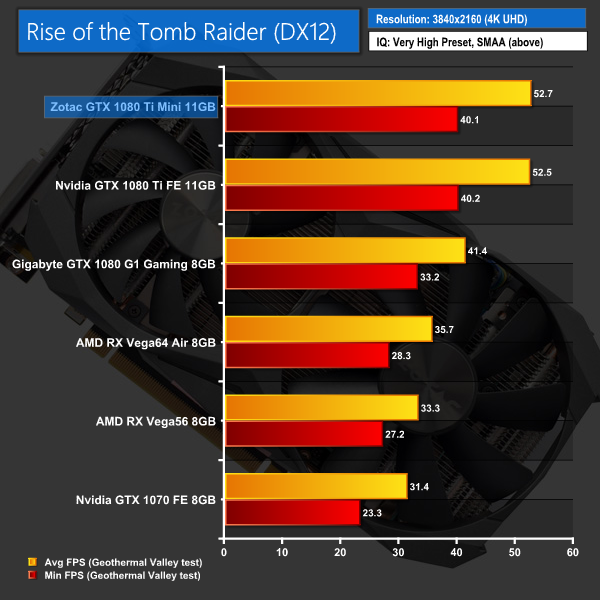
Now testing Rise of the Tomb Raider, we see more than 'toing and froing' betwixt the two GTX 1080 Ti'southward – the Mini is fastest at 1080p, falls just short at 1440p, but comes dorsum to edge Nvidia'southward Fe card at 4K. There really is not much to separate these cards at all.We kickoff measure system-wide power describe from the wall while the card is sat idling at the Windows 10 desktop for 5 minutes. Gaming power depict is recorded by running the Deus Ex benchmark at 4K. Every bit a maximum stress exam, Burn Strike Ultra Stress Test is run 5 consecutive times and the cards' ability draws are recorded.
Note: due to some logistics issues, nosotros are unable to present information for the GTX 1070 and GTX 1080 cards in this test.

Compared with Nvidia's reference design boards, the Zotac Mini only draws around 10-15W more, despite the carte using two 8-pin PCIe power connectors, instead of 1x 8-pin and 1x 6-pivot. This small bump to the power consumption must be due to the +38MHz factory overclock.
In any case, if yous are a looking for a GTX 1080 Ti, an extra fifteen-or-so Watts is not going to scare you off.We first measure GPU temperature while the bill of fare is sat idling at the Windows 10 desktop for five minutes. Gaming GPU temperature is recorded past running the Deus Ex benchmark at 4K. As a maximum stress test, Fire Strike Ultra Stress Test is run 5 consecutive times and the cards' GPU temperature levels are recorded.
Ambient room temperature was held at around 23°C.
Note: due to some logistics bug, nosotros are unable to present data for the GTX 1070 and GTX 1080 cards in this examination.
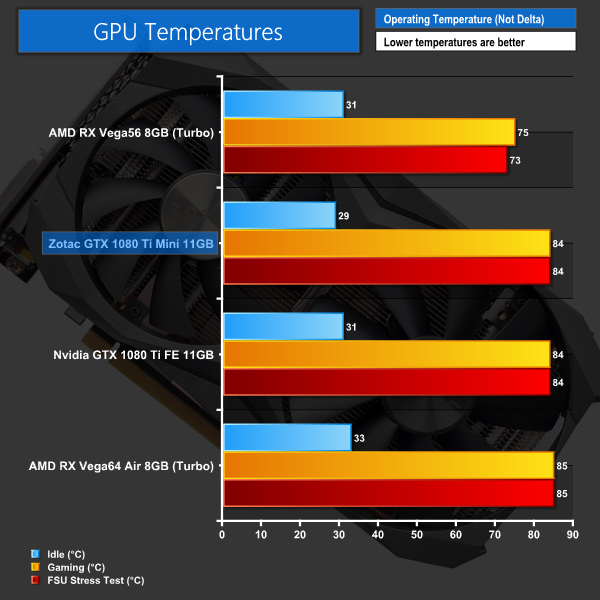
Non surprisingly, the Zotac Mini runs rather hot – 84C is actually the default thermal limit, and inside a simply few minutes of gaming the card will hit that limit and stay there. This causes GPU Boost three.0 to lower the scrap's cadre frequency over time, hence why we saw Nvidia's Founders Edition card out-performing the Mini in some titles.
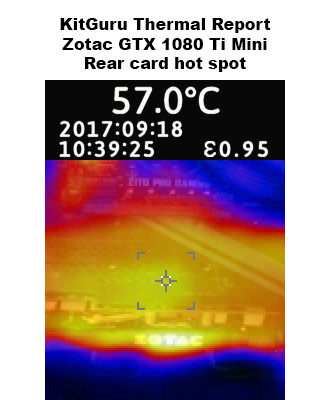
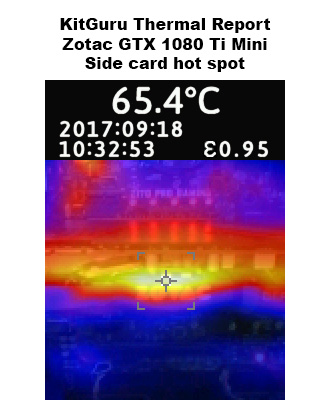
The card's backplate and shroud remain quite cool, even so, with a hotspot of 57C on the rear of the card. At that place are a couple of capacitors on the side of the carte du jour, simply above the Zotac logo, and these reached upwards to 66C during our stress examination – but that is still well inside thermal limits.We have our noise level measurements with the decibel meter on the tiptop and heart department of the example, overhanging the side console (power supply side, not motherboard tray side) by exactly 1 inch to avoid any airflow pressure level coming from the exhausting AIO cooler.
I measured the audio floor to exist 34 dBA, thus anything above this level tin can be attributed to the graphics cards. The power supply is passive for the entire power output range we tested all graphics cards in, while all CPU and system fans were disabled.
Noise levels were measured after 5 minutes under three scenarios: desktop idle, Deus Ex: Mankind Divided at 4K, and the Fire Strike Ultra stress exam.
Note: due to some logistics problems, we are unable to nowadays information for the GTX 1070 and GTX 1080 cards in this test.

In truth, none of the iv cards tested above are quiet cards. The Zotac Mini may not be louder than either of the new AMD Vega cards, but it is all the same not the most pleasant thing to listen to. Given that information technology is an aftermarket carte, yet it is yet louder than Nvidia's Founders Edition, probably tells you lot everything you need to know well-nigh the GTX 1080 Ti Mini.
I don't want to be besides harsh here, as cramming such a powerful GPU into such a small physical blueprint was always going to outcome in compromises. Even so, the Zotac Mini is particularly audible when idling – its fans would not spin below 45%, or around 1400 rpm, even when sat on the desktop for xv minutes with 0% load on the card. Suffice to say, if you are looking for atranquillity GTX 1080 Ti, yous would be best served by one of the much larger partner cards.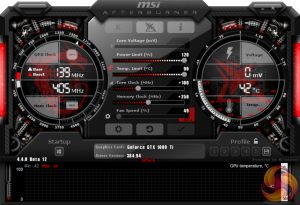
My best overclocking results came with +100MHz added to the cadre, +250MHz to the memory, with power and temperature sliders at their maximum levels.
When running Fire Strike, this overclock helped the card hit a acme frequency of 1923MHz, though it only took a couple of minutes to settle at around 1835MHz. The card did run very hot, however, as the core temperature continued to rise until itagain hit the new thermal ceiling of 90C. Noise levels were almost unbearable, too.
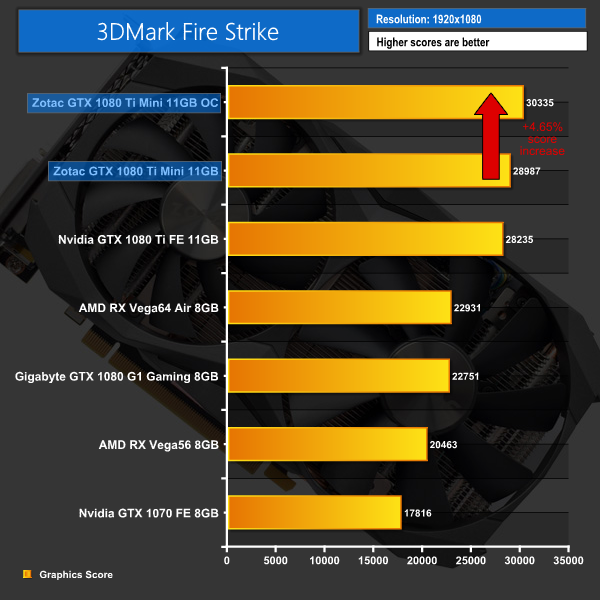
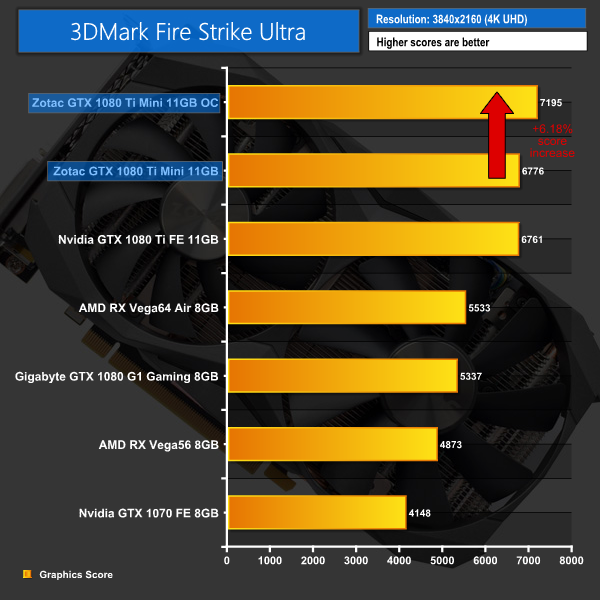
Still, this overclockdid bring some tangible gains – equally demonstrated to a higher place. An boilerplate 5% operation increase is non to exist sniffed at.
That existence said, it is my stance that the extra heat and racket are really non worth information technology. I would suggest a GTX 1080 Ti is fast plenty already, and considering the size limitations of the Zotac Mini, leaving the card in an overclocked state may not be the best idea.Zotac has certainly pulled off quite the feat of engineering with itsGTX 1080 Ti Mini. The world'due south smallest GTX 1080 Ti, the Mini measures just 211mm long and is probable to fit in almost any case on the market right now.
It is a practiced-looking card, too, with a neutral gunmetal grey shroud and backplate. Given Zotac has a history of incorporating yellow accents into its card designs – something which certainly splits opinion – it is good to see the company opt for a menu design that will work with almost any colour scheme.
When we come to functioning, my testing suggests there is not much between the Mini and Nvidia's Founders Edition card. Looking over the data, the Mini might border ahead in ane examination, only for the Founders Edition card to retake the lead in the next.
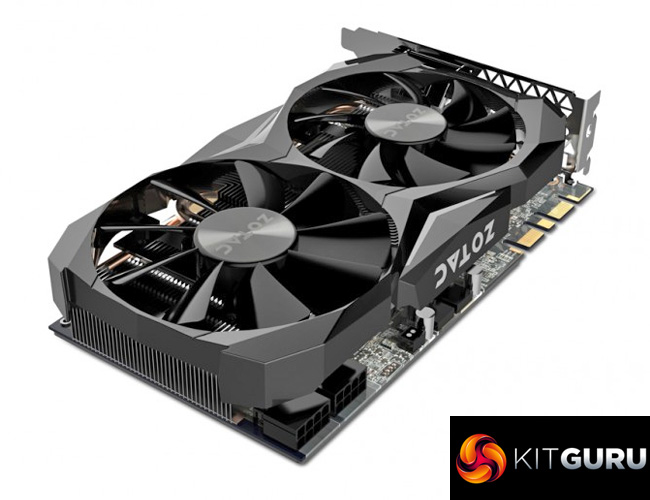
This is despite the Zotac Mini boasting a +38MHz factory overclock when compared with reference speeds. In practice, this overclock did not make much difference as the Zotac Mini rapidly reached its thermal limit of 84C, resulting in GPU Boost 3.0 lowering its cadre frequency – to the point where the Founders Edition card actually ran effectually 40MHzfaster throughout our testing.
Yet, a GTX 1080 Ti is a GTX 1080 Ti – factory overclock or not, the GP102 flake is very capable and we still saw fantabulous frame rates from the Zotac Mini. The trade off comes, as I alluded to, when we get to thermal and noise levels.
Essentially, the Zotac menu will run at whatever thermal ceiling you gear up – all the fashion upwardly to 90C. This also means the fans are constantly spinning at quite a stride, and that means the Mini is audible at all times. Information technology is also particularly noticeable when idling, equally I did not see the fan speed driblet below 45% (1400 rpm) – fifty-fifty with 0% load on the card.
In sum, the Zotac GTX 1080 Ti Mini is an impressive card – to take such a powerful GPU and put it into such a small package, successfully, is certainly worthy of praise. The thermal and dissonance concerns are certainly significant, simply information technology actually depends on your use case equally to whether or non you lot should buy this card. Those looking for a GTX 1080 Ti for their mid-belfry can forget it, but if you really want something tiny – maybe for a HTPC or ITX LAN rig – then the Zotac Mini is well worth a shout.

You can buy one from Overclockers Uk for £698.99 Hither.
Discuss on our Facebook page, over HERE.
Pros
- Very small.
- Neutral colour scheme.
- GTX 1080 Ti is however fast – even if GPU Boost causes the core frequency to slow down over fourth dimension.
- Actually i of the cheaper aftermarket GTX 1080 Ti cards.
Cons
- It will run at its thermal limit, even upward to 90C.
- Fans emit a fair flake of noise.
KitGuru says: Overall, the Zotac GTX 1080 Ti is an impressive carte. Its limitations are not worth information technology if you simply want something for your standard mid-tower – just for those looking for a lot of power in a tiny parcel, information technology has proved to be well worth buying.

Get a Patron!
Be sure to check out our sponsors shop EKWB hither: https://ek.tech/kit-guru
Pages: 1 2 iii 4 five 6 7 viii 9 10 11 12 xiii 14
0 Response to "1080 Ti Mini Review Tom's Hardware"
Post a Comment